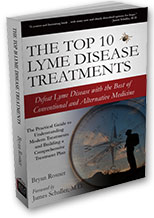|

Author Ken Singleton, M.D.
Excerpts from the Lyme Disease Solution:
Table
of Contents
Introduction
Chapter 1
Chapter 2
Chapter
3
Chapter 4
Chapter 5
Chapter 6
Chapter 7
Chapter 8
Chapter 9
Index
See our complete selection
of Lyme disease books and DVDs.
Customers who purchased The Lyme Disease Solution also
purchased the following book:

The Top 10 Lyme Disease
Treatments by Bryan Rosner
|
|
Paperback Book, 523 Pages, $29.95

The Second “Core” Component of Lyme Therapy: Basic Lifestyle Health
Principles and Nutritional Supplementation
I addressed antibiotics earlier in this chapter because their proper use is critical to the effective treatment of Lyme and the TBDs. In the remainder of this chapter, I will be sharing with you the core general-health principles and alternative and complementary therapies that I recommend for virtually all my Lyme/TBD patients.
Additional therapies for common specific problems and/ or issues associated with Lyme—such as detoxification, lack of energy, hormonal dysfunctions, chronic inflammation, neurological factors, pain, sleep problems, and others—are discussed in chapters 7 and 8. Chapter 9 addresses additional therapies and self-care measures for achieving and maintaining overall psychological and spiritual well-being.
General Care—All Patients
What follows are the essential elements of the general care program I recommend for all patients with Lyme and TBDs. In addition to these steps, adjunctive alternative therapies, which I also discuss below, may also be advised.
1) The Lyme Inflammation Diet (LID). Since I discussed this diet and its rationale in detail in the last chapter, there is no need to go into detail about it here. Please review chapter 5 and be sure to follow the dietary recommendations you will find there for each of the stages of the diet. The reason I stress the importance of the LID is that it effectively helps to minimize and reverse the effects of chronic inflammation. Chronic inflammation is one of the main reasons so many patients with Lyme fail to improve. As I mentioned in chapter 5, once inflammation is brought under control, your body will become better able to mobilize its defenses against Lyme and other TBDs. Additionally, the Lyme Inflammation Diet is also highly effective in help your body to detoxify and rid itself of toxins. The diet will also help minimize your risk of developing candidiasis (systemic yeast infection), as well as help you to bring yeast infection under control if you already suffer from it. Of course, the LID principles would include complete abstinence from both alcohol and tobacco usage during treatment. Ongoing users of these substances generally do poorly with Lyme therapy.
2) Targeted Nutritional Supplementation. This is a very important next topic of discussion because most, if not all, patients with chronic Lyme and TBDs suffer from nutritional deficiencies. Chronic infection, along with chronic inflammation and oxidative stress (discussed in chapter five), cause this situation. In a depleted state, unfortunately, a healthy diet alone is often unable to completely address the situation. For this reason, I recommend that all patients take a general, high quality multi-vitamin and mineral supplement on a daily basis.
At this point, I wish to address the most common vital nutrient deficiencies that afflict many patients with Lyme and other tick-borne diseases. They are vitamins A, B-complex (especially vitamins B12 and B6), C, and D, as well as the mineral magnesium.
Vitamin A: The first vitamin ever to be discovered, vitamin A is not a single substance, but actually a complex of nutrients that include carotenoids and retinol. Vitamin A has many health functions in the body, including proper bone growth, cell differentiation, healthy eyesight, proper gastrointestinal and respiratory function, and tissue repair. For patients with Lyme and other TBDs, vitamin A is particularly important because of its significant ability to improve immune function and fight infectious disease and its role as an important antioxidant. Deficiency of vitamin A may prolong the course of Lyme arthritis. I recommend a daily intake of 3–5,000 IU of ‘fatsoluble” vitamin A itself and an additional 5–10,000 units of “water-soluble” mixed carotenoids that the body can covert to vitamin A if needed. (As a precaution, vitamin A supplementation should not be used in pregnant women without supervision of an obstetrician.)
B-complex Vitamins: B vitamins are water soluble, meaning that they cannot be stored in the body and therefore must be obtained every day from the foods you eat and, if necessary, as a nutritional supplement. The full range of B vitamins includes B1 (thiamine), B2 (riboflavin), B3 (niacin), B5 (pantothenic acid), B6 (pyridoxine), B9 (folic acid), and B12 (methylcobalamin). B vitamins work together in the body, and therefore, when taken as a supplement, they should be part of a complete B-complex formula.
I have found that deficiencies of vitamins B12 and B6 are common in patients with Lyme and other TBDs. The reason vitamin B12 is so often deficient is that it is not found in significant amounts in plant foods. It is also easily depleted by stress, a common co-factor in chronic Lyme disease. Absorption from the intestines may be erratic, especially in the elderly. B12 plays many roles in the body, including helping to manufacture protein from amino acids and aiding in the metabolism of proteins, carbohydrates, and fats. It is also necessary for proper functioning of the nervous system and aids in the body’s production of red blood cells. Additionally, B12 can boost energy levels in the body and help to counteract poor gastrointestinal problems, memory problems, and mood swings.
I recommend that virtually all patients with Lyme and related TBDs have a blood test to determine their vitamin B12 nutritional status. If a person is a vegetarian, a vegan, or on a macrobiotic diet, it is especially important that a blood test for B12 be done to assess one’s B12 status. For patients with significant neurological Lyme problems, it may be important also to order two other tests: (1) homocysteine level and (2) a functional test for vitamin B12 called urinary “methylmalonic acid.” If it is found that you have blood B12 levels less than 500 picograms/milliliter, elevated homocysteine, or an abnormally elevated urinary methylmalonic acid, then intramuscular injections of this important vitamin may be advised, along with supplementing with sublingual B12. I prefer the methylcobalamin or oxycobalamin preparations over cyanocobalamin. The dosage range for sublingual B12 is 1,000–2,000 mg per day. The intramuscular dose is 1,000 mg weekly.
Vitamin B6 deficiency may cause significant problems also. Among those problems are elevated homocysteine levels, carpal tunnel syndrome, anxiety (especially when combined with a deficiency of the minerals manganese and zinc in a condition called pyroluria—see my Web site for more information), depression (vitamin B6 is a necessary cofactor for serotonin production), premenstrual syndrome (PMS), migraines, kidney stones, tremors, and others.
A good diagnostic clue to B6 deficiency is an elevated blood homocysteine level. Specific blood tests for vitamin B6 can also be done. Generally, vitamin B6 is given in a dose range of 50–100 mg per day. Often vitamin B6, which is called pyridoxine, will be combined with an even more effective form of vitamin B6 called pyridoxal-5-phosphate. This is a very effective way to take vitamin B6 and highly recommended. It is also my usual practice to combine vitamin B6 with a good quality magnesium supplement, since these two nutrients work together in many biochemical processes in the body.
Remember, the standard American diet is often associated with inadequate vitamin B6 and magnesium, especially a diet that contains significant amounts of alcohol, white flour, and refined sugar, each of which tends to deplete the body of both of these essential nutrients.
Vitamin C: Another water soluble nutrient, vitamin C is perhaps the most versatile and important vitamin because of the wide range of functions it supports in the body. Its importance for patients with Lyme and other TBDs has to do with its powerful immune-boosting properties, its effectiveness in fighting infectious microorganisms, and its role as a potent antioxidant and detoxifying agent. It also acts as a natural antihistamine (especially when combined with the bioflavonoid, quercitin), making it an important nutrient for managing inflammation. Vitamin C is also essential for the overall health of the body’s blood vessels, bones, cartilage, joint linings, ligaments, skin, and teeth, as well as for wound healing. Additionally, along with B vitamins, it is one of the most important nutrients for coping with stress and also plays important roles in the metabolism of amino acids and cholesterol and in the manufacture of hormones by the body. For patients with Lyme/TBDs, I routinely recommend a daily oral dose of vitamin C ranging from 500–2,000 mg per day in divided doses. The Lyme Disease Solution 2 6 4
Vitamin D: Vitamin D is a nutrient that in recent years has become increasingly recognized for its health properties. Additionally, recent research suggests that a high percentage of people in the United States are deficient in vitamin D, especially those who usually receive little to no exposure to natural sunlight on a daily basis. Additionally, vitamin D levels in the body typically diminish after the age of 40. A study published in June 2007 in the American Journal of Clinical Nutrition showed that supplementation of vitamin D in older women reduced their risk of cancer by an amazing 60 percent.
Among its many important roles, vitamin D helps support the body’s endocrine system, especially the adrenal and thyroid glands. Studies in recent years have shown that vitamin D plays a major role in the regulation (not mere suppression) of the immune system. It has been shown that low vitamin D levels are associated with increased levels of inflammatory markers such as IL-6, TNF-alpha, and CRP. As I discussed in chapter 4, vitamin D plays an important role in the reduction of autoimmunity by helping the body to control excessive Th1 responses. Its immune-regulatory function is vital to good health.
Treatment with vitamin D can reduce musculoskeletal pain in a certain percentage of Lyme patients. For this reason, I believe that Lyme patients with chronic inflammatory problems should be assessed for vitamin D deficiency with a blood test called “25-hydroxy vitamin D.” Supplementation with sunlight Core Treatment Strategies for Lyme Disease and Other Tick-Borne Diseases 2 6 5 or oral vitamin D should be done if levels are low (less than 40 ng/mL). The usual oral supplement dosage for vitamin D (D3 or cholecalciferol is the preferred form of vitamin D) is 400–5,000 IU per day, depending on the level of deficiency. The goal of vitamin D supplementation (along with sunlight) is to achieve a level of 45–60 ng/mL. I don’t recommend levels over 70 ng/mL for prolonged periods of time.
Interestingly, sunlight may result in formation of 10,000–20,000 IU per day, but feedback control mechanisms in the skin prevent toxic vitamin D blood levels from occurring. Therefore, if your vitamin D level is too high, the elevated blood level must be occurring from oral intake of vitamin D and not from sunlight. Finally, there is one exception to my vitamin D recommendations above. If a person has Lyme and a condition called “sarcoidosis,” then restriction of vitamin D may be useful.
Magnesium: Both Lyme and Bartonella significantly deplete the body’s supply of magnesium. Magnesium is one of the most important mineral nutrients necessary for good health, and also one of the minerals that Americans in general are most commonly deficient in. The recommended daily intake of magnesium for healthy people is 400 mg per day, but the sad reality is that the average American gets about half that amount per day. The best nutritional sources include green foods, especially collards and chard (magnesium is to chlorophyll what iron is to hemoglobin), orange-colored foods, nuts, chocolate, figs, apricots, coconut, bran, oats, beans, and legumes.
Most widely known for its ability to support the health of the bones, heart, skeletal muscles, and teeth, magnesium also plays essential roles in the maintenance and repair of all body cells, energy production, hormone regulation, nerve transmission, and the metabolism of proteins and nucleic acids. It also helps to reverse muscular tension and is involved in the functioning of literally hundreds of the body’s enzymatic reactions. A lack of magnesium can also contribute to immune system dysfunction, depression, fatigue, high blood pressure, high cholesterol, gastrointestinal problems, irregular heartbeat, memory problems, mood swings, muscle spasms and twitching, and motor skill problems.
Many chronic symptoms of Lyme/TBDs are related to magnesium deficiency, and the correction of that deficiency can be very effective in relieving those symptoms. For that reason, I routinely test nearly all patients with chronic Lyme symptoms for magnesium deficiency. The problem with blood testing is that the magnesium blood test should be done on the red bloods cells and not the serum. This is because magnesium exists primarily inside of cells (intracellular, as in red blood cells), and deficiency will not be detected in fluid outside of the cells (extracellular, as in serum or plasma) until a very profound deficiency exists. If you can afford it, the best, and also most expensive, test is the blood “ionized” magnesium (performed by most large commercial labs).
If blood testing shows low levels of magnesium and if kidney function is good, supplementation is highly recommended, in a dosage range of 400–1,000 mg per day. Take in divided doses because taking large amounts of magnesium may result in loose stools. There are many good products on the market, the best of which contain primarily magnesium chloride or “chelated” magnesium (such as taurate, citrate, aspartate, glycinate, and others.)
Coenzyme Q10: Coenzyme Q10 (CoQ10) is a vitaminlike substance that is found in food. It is not a true vitamin since it can also be synthesized by the body, with lessening amounts produced as we age. CoQ10 plays a variety of intricate and important roles in your body’s ability to produce energy. Perhaps its most important role is that of helping the cells’ mitochondria manufacture cellular fuel, known as adenosinetriphosphate, or ATP. The amount of ATP produced by the cells is directly related to energy levels. The more ATP that is produced, the more energy is available. Without an adequate supply of CoQ10, the cells are unable to produce enough ATP, resulting in energy loss and fatigue. CoQ10 also acts as a fat-soluble antioxidant. It enhances the ability of its fellow fat-soluble antioxidant, vitamin E, to do its job. CoQ10 is a critically important nutrient for the heart, improving energy production in heart cells. Heart muscle biop- The Lyme Disease Solution 2 6 8 sies of Lyme patients often show CoQ10 deficiency, according to Dr. Burrascano. In fact, this deficiency may be a major causative factor in the chronic fatigue of some Lyme patients. An important additional risk factor for CoQ10 deficiency is the use of cholesterol-lowering drugs called “statins.” (I generally avoid the statin drugs in patients with chronic fatigue, but for those who must take the statin medications, I recommend supplementation with CoQ10 and fish oil.)
This versatile nutrient has other important functions. CoQ10 can be very helpful in the regulation of high blood pressure. Combined with L-carnitine, it can help patients with congestive heart failure. It also helps to improve immune function and has anti-cancer properties. Finally, it may act as a powerful brain anti-oxidant and “neuro-protector” (especially against neurodegenerative disorders such as Parkinson’s disease).
The usual dosage range for CoQ10 is 50–200 mg per day. As a reminder, CoQ10 (and also alpha lipoic acid and vitamin E) should not be used while you are using the anti-Babesia drug atovaquone (Mepron, Malarone) because CoQ10 interferes with the action of this medication. While CoQ10 supplementation on its own can often improve energy levels, I have found that best results are achieved when CoQ10 is taken along with a full range of other essential vitamins, minerals, and other nutrients.
If you would like
to learn more about the book before ordering it, feel free to browse
these excerpts, which are available online, free of charge:
Table
of Contents • Introduction
• Controversy
and Background
Symptoms
• Testing
and Diagnosis • Natural
Killer (NK) Cells
Anti-Inflammation
Diet • Medical
History and Physical Exam
Low
Dose Naltrexone (LDN) • Food,
Diet, and Omega Fatty Acids
Hope
and Positive Outlook • Index
"What I have accomplished with this 500+ page book, The Lyme Disease Solution, is to share my everyday knowledge and practical experience of 10 years as a Lyme-enlightened practitioner (who also is himself a Lyme-survivor). Although I hesitate to use the “cure” word in relation to chronic Lyme, the principles in this book have resulted in a greater than 90% response rate in my patients. At least 60% of my patients achieve long-term improvement that allows them to get off of antibiotics completely."
— Ken Singleton, M.D.
|
THE LYME DISEASE SOLUTION
By Ken Singleton, M.D.
Foreword by James A. Duke, Ph.D.
Paperback Book, 523 Pages, $29.95 + $7 Shipping & Handling |
|

|
Order By Phone: |
Order Online: |
| (530) 541-7200 |
 |
 |
BioMed
Publishing Group
P.O. Box
9012
South Lake
Tahoe, CA 96150
www.LymeBookStore.com
Contact Us
(801)
925-2411
|
Disclaimer:
The
products offered on this web site are intended for
informational and educational purposes only and are not
intended to prevent, diagnose, treat, or cure disease.
The statements on this web site have not been evaluated by
the United States Food and Drug Administration. If you have
a medical problem see a licensed physician.
Copyright
© 2007 BioMed | Advertise
with us
|
|
